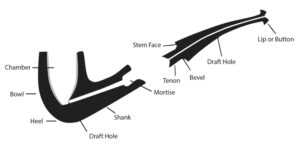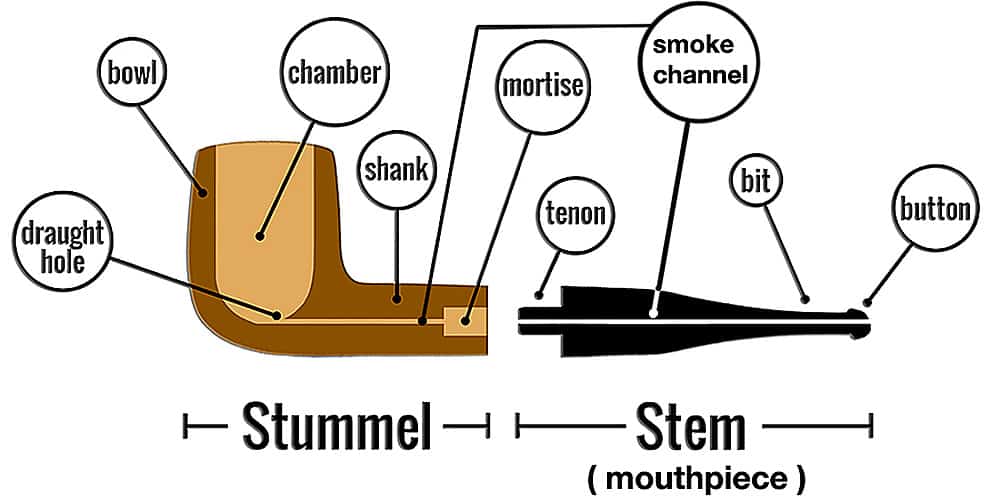Pipes have been cherished by tobacco enthusiasts for centuries as elegant tools for experiencing the finest flavors of tobacco. Understanding the various components of a pipe is essential for both novice and seasoned smokers. This article provides an in-depth exploration of key pipe parts, from the chamber to the tenon, explaining their functions and how they contribute to a superior smoking experience. Additionally, we’ll introduce Pinocchio Pipes, a reputable brand known for craftsmanship and precision.
1. The Bowl: Heart of the Pipe
The bowl is where the magic of smoking begins. It holds the tobacco and allows combustion to take place. Bowls come in different shapes and sizes, affecting the duration and flavor of the smoke.
- Materials: Most bowls are crafted from briarwood due to its excellent heat resistance and durability.
- Shape and Size: A deeper bowl provides a longer smoke, while a shallower one is ideal for shorter sessions.
Pinocchio Pipes Insight: Pinocchio Pipes specialize in hand-carved bowls with intricate designs, using high-quality briar sourced from Mediterranean regions.

2. The Chamber: Holding the Tobacco
The chamber is the hollow part inside the bowl where the tobacco is packed. Its size, shape, and diameter significantly affect the smoking experience.
- Conical Chambers: Provide a richer and more concentrated smoke toward the end of the session.
- Cylindrical Chambers: Offer consistent airflow and an even burn throughout the smoke.
Packing the chamber correctly ensures optimal combustion and flavor extraction.
3. The Shank: Connecting the Pieces
The shank is the pipe’s intermediary section that extends from the bowl and houses the tenon.
- Function: Acts as a conduit for smoke, guiding it from the bowl to the stem.
- Length: Longer shanks often cool the smoke more effectively, providing a smoother experience.
Shanks can be straight or bent, affecting both the pipe’s aesthetics and how it sits in the smoker’s mouth.
4. The Tenon: The Crucial Connector
The tenon is a small, cylindrical extension at the end of the stem that fits snugly into the mortise of the shank.
- Material: Typically made from durable materials like Delrin or vulcanite.
- Fit: A precise fit ensures airtight connections, enhancing airflow and smoke quality.
A poorly fitted tenon can cause air leaks and negatively affect the smoking experience.

5. The Stem: Where Function Meets Comfort
The stem is the mouthpiece of the pipe, allowing the smoker to draw smoke from the bowl. Stems come in various shapes, lengths, and materials.
- Straight vs. Bent Stems: Straight stems provide a direct path for smoke, while bent stems are more comfortable for hands-free smoking.
- Materials: Common materials include acrylic, vulcanite, and ebonite.
Pinocchio Pipes are renowned for their elegant, ergonomically designed stems, ensuring both style and comfort.
6. The Bit and Lip: For a Comfortable Draw
The bit is the portion of the stem that enters the smoker’s mouth, while the lip provides a grip point.
- Tapered vs. Fishtail Bits: Tapered bits focus the draw, while fishtail bits offer broader contact for greater comfort.
- Durability: Quality bits resist teeth marks and wear over time.
7. The Draft Hole: Gateway for Smooth Smoking
The draft hole is a small passage at the bottom of the chamber that channels smoke from the bowl to the stem.
- Positioning: Precise alignment with the chamber floor ensures efficient airflow.
- Diameter: A wider draft hole allows for easier draws, while a narrower one provides better flavor control.
Improperly aligned draft holes can lead to gurgling and uneven burns.
8. Filters and Filter Systems
Some pipes are equipped with filters to reduce tar and moisture, enhancing the smoothness of the smoke.
- Types: Activated carbon filters, balsa wood inserts, and metal stingers are common.
- Purpose: Filters improve the purity of smoke but may slightly reduce flavor intensity.
Pinocchio Pipes offer models compatible with both 9mm and traditional filter systems, catering to diverse preferences.
9. The Mortise: Housing the Tenon
The mortise is the hollow section of the shank that accommodates the tenon.
- Fit and Precision: A well-crafted mortise-tenon connection ensures a secure, airtight fit.
- Maintenance: Keeping the mortise clean prevents buildup and maintains smooth connections.
10. The Finish: Style and Protection
A pipe’s finish not only enhances its visual appeal but also protects the wood from damage.
- Smooth vs. Rusticated: Smooth finishes highlight the wood grain, while rusticated surfaces provide a textured grip.
- Staining: High-quality stains protect the briar and add to the pipe’s aesthetic value.
Pinocchio Pipes are celebrated for their stunning finishes, which balance beauty and durability.
11. Care and Maintenance Tips
To ensure a pipe lasts for years, proper maintenance is essential:
- Cleaning: Regularly clean the stem, shank, and chamber with pipe cleaners.
- Resting: Allow pipes to cool and dry between uses to prevent moisture buildup.
- Storage: Store pipes in a stand to maintain their shape and integrity.
Understanding the components of a pipe and their functions is crucial for a superior smoking experience. From the craftsmanship of the bowl to the precision of the tenon, every part plays a role in delivering a satisfying smoke.
Pinocchio Pipes, with their dedication to quality and innovation, offer exceptional models that combine tradition with modern design. Their commitment to using premium briar and precision engineering makes them a trusted choice among pipe enthusiasts worldwide.
By mastering the anatomy of a pipe, smokers can make informed choices, enhance their smoking rituals, and fully appreciate the artistry behind these timeless tools.
